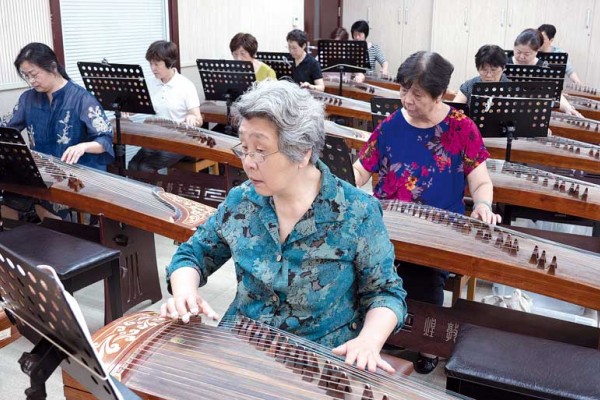
Students learn to play traditional Chinese musical instruments at a school for the elderly on Nantangbang Road in Shanghai. [Photo/China Daily]
China changed the family planning policy further in 2021, allowing all couples to have three children, in an effort to arrest, if not reverse, the declining birthrate and counterbalance the fast rising aging population. The low fertility rate and increasing population mobility are becoming normal in China, while the family structure is becoming simpler and family size smaller.
Given these demographic changes, it is difficult for people who work full-time to take care of their elderly parents, who prefer living with their children rather than shifting to old age homes because, according to Chinese tradition, adult children are expected to take care of their elderly parents.
China's eldercare system is often described as a "9073" structure, meaning 90 percent of the elderly people are cared for by their offspring, 7 percent receive community care, and 3 percent live in nursing or old age homes. Hence, the government has introduced plans to promote the integration of home care and community care to meet the large-scale demand for eldercare.
Home-based care services are inclusive, easily accessible and diversified. They allow communities to provide eldercare services for those living at home irrespective of their age and income. Senior citizens can access convenient and affordable services to improve the quality of their life while living at home. Also, communities can provide diversified eldercare services for senior citizens in education, medical treatment and leisure activities and other fields.
However, the availability and quality of services cannot meet the increasing demand of diversified home-based eldercare. At present, most communities can only provide basic services, rather than professional rehabilitation care, short-term care and counseling for the elderly people. Another problem is that the elderly people are reluctant to pay for the services, impeding the development of a diversified and market-oriented eldercare industry.
Moreover, due to the low pay and physically demanding work, the eldercare industry cannot hire care givers for the long term. In fact, there is a huge shortage of professional eldercare givers despite an array of supportive policies and measures.
Although the eldercare industry can get government subsidies, they are caught between profit seeking and providing good eldercare services due to the high labor cost and shortage of professional care givers. Also, low investment returns have weakened private companies' zeal to pour capital into the eldercare industry, and the eldercare companies' dependency on government subsidies has restricted their high-quality development.
Therefore, there is a need to reform the legal and credit systems for the eldercare industry. It is also necessary to improve the quality of community-based eldercare services to meet the increasing demand for such services.
First, efforts should be made to build more or improve the existing supporting facilities and develop senior citizen-friendly communities, for which governments at all levels need to introduce tailor-made standards. While multiple channels, including private fundraising, government subsidies and procurement, should be used to help families in need, barrier-free environments need to be built to help develop elderly people-friendly communities and reward well-functioning communities.
Second, measures should be taken to ensure professional healthcare services are accessible to all communities because, by the end of 2021, over 190 million senior citizens were suffering from chronic diseases, with 75 percent of them living with more than one chronic disease, and over 45 million elderly people had functional disability.
And while the quality of healthcare institutions in counties and communities should be improved and door-to-door eldercare services at reasonable cost provided, a comprehensive eldercare network needs to be built and institutions encouraged to provide more integrated medical and eldercare services.
Third, governments at all levels should guide and promote information and communication technology (ICT) enterprises to help improve community-based eldercare services. To narrow the digital gap, the State Council, China's Cabinet, issued a notification in 2020, urging all stakeholders to make more efforts to help the elderly people adapt to the internet and apps, and urging ICT enterprises to develop senior citizen-friendly apps.
And fourth, the high-quality development of the eldercare industry requires optimized legal and credit systems, so that eldercare workers and supervisors can better understand their responsibilities and obligations. It is also necessary to set the standards for the assessment of eldercare providing enterprises, establish a transparent credit platform to protect elderly people's rights, build a fair market environment and promote high-quality eldercare services.